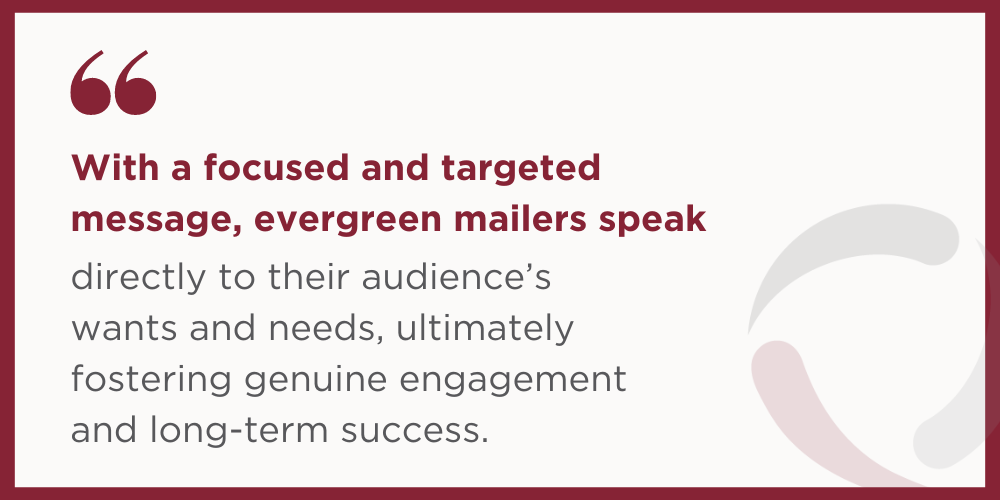Your Guide to a Sustainable, Evergreen Mail Program

Sustainable direct mail has become a buzzword as brands find ways to make their campaigns more environmentally friendly. Yet, sustainability means more than just using eco-friendly materials and minimizing waste. It also involves creating long-lasting, evergreen mail programs that can be continuously improved for ongoing effectiveness and scalability.
In this article, we’ll explore the importance of an evergreen mail program, and share best practices from established and profitable mailers.
|
Prefer to listen? Check out our podcast The Direct Effect: Your Guide to a Sustainable, Evergreen Mail Program |
In a Nutshell: What is an Evergreen Mail Program?
A direct mail program that is “evergreen” is not a static campaign but a dynamic, ongoing effort. It’s a testament to a brand’s commitment to continuous improvement and innovation. By constantly optimizing and refining, you can ensure your campaigns stay relevant and effective.
Brands with an evergreen mail program:
- Maintain a consistent flow of leads and sales over time
- Focus on sustaining the campaign over time without needing constant reinvestment
- Ensure consistent and reliable results over time
These programs use multivariate testing and data-driven insights to ensure consistent performance, reliable sales, and sustainable success, aiding in better planning and budgeting. It all starts with testing—using methodologies like FaQtor Test™ to identify the best creative, offer, and audience combinations. The winning combinations are then validated and rolled out across all channels, guaranteeing scalable success and ROI protection.
Four Reasons Why Evergreen Mailers Thrive
1 – Budget Optimization
Despite the costs associated with data, paper, print, and postage, direct mail remains highly effective for customer acquisition campaigns. With a data-driven approach, the mail channel can deliver quick and exponential growth, far outweighing the expenses and quickly generating a positive return on investment. According to ANA, direct mail ROI has surpassed digital mediums by an average of 161%.
When a brand maintains consistency in mailing and testing schedules, they can shift their focus towards sustaining the campaign over time without requiring constant reinvestment. Predicting and stabilizing costs ensures long-term viability, efficient resource allocation, budget optimization, and higher ROI.
Experienced mailers can enjoy significant advantages when scaling up their direct marketing efforts. This means that as they expand their audience or grow their customer base, they can increase their revenue without incurring a proportional rise in costs. Such a strategic advantage allows them to maintain or even improve profitability over time.

2 – Targeting Flexibility
Sophisticated modeling is the driving force behind successful direct mail campaigns. Using rich offline customer datasets, you can pinpoint the most promising prospects and tailor your messaging accordingly. Brands with established direct mail programs prioritize hyper-targeted campaigns to reduce waste, ensure deliverability, and increase response rates.
Securing delivery to the right mailbox is no small task. Evergreen mailers continuously experiment with new data sources, such as custom models, to enhance their effectiveness. They are also open to new ways of engaging audiences, such as sending winback or retention messages to customers to retain them before subscriptions end, or leveraging offline data sources to target prospects in online environments.
It’s important to note that a sustainable direct mail program typically doesn’t exist in isolation. Instead, it is integrated with other marketing channels to ensure a cohesive and consistent customer experience. Our most successful clients use SeQuel Surround™ to reach their best prospects with relevant and timely digital touchpoints concentrated around their mail drop window—creating awareness, encouraging engagement, and generating conversions while eliminating ad budget waste.
3 – Strategic Messaging and Design
Direct mail marketing offers a unique advantage over other channels by allowing you to break free from digital marketing’s space and time limitations. With a focused and targeted message, evergreen mailers speak directly to their audience’s wants and needs, ultimately fostering genuine engagement and long-term success. This is more important than ever, as clear and concise copy gives 55% of consumers a positive impression of direct mail ads.
By sending personalized and compelling direct mail pieces, these brands tell captivating stories about their product or service that resonate and drive response. They harness direct mail’s tangible nature to create a deeper connection with their audience, increasing brand loyalty and customer retention.
To maximize response rates, it is essential to integrate innovative approaches and creative best practices. It all circles back to continuously experimenting with various formats and offers and testing regularly to identify the most effective strategies and establish a robust control. Experienced mailers also prioritize responsiveness in communication with their agency, ensuring prompt approvals to keep campaigns on track.

4 – Accurate Performance Analysis
While you may know that your advertisement aired on the local news at 10:15 p.m., you cannot be sure if the TV was on, if your intended audience was attentively watching, or if anyone was even in the room. However, with direct mail, you can be confident that your message was delivered to the right audience. This level of precision makes brands continue to use direct mail, as it assures them that they are reaching their intended audience on a medium they engage with each day.
Direct mail provides a physical connection between marketing efforts and consumer actions, allowing evergreen mailers to accurately track campaign performance. Using matchback and holdout strategies, they can validate campaign results from awareness to action across various channels.
Brands with sustainable programs also stay open to new ways of measuring channel performance. For instance, you may opt to hold out a portion of your audience as a control or no-mail segment to measure the incrementality of your mail program. This can give you confidence that your marketing efforts are generating an incremental lift—meaning you are only getting sales you wouldn’t have received without the benefits of your mail campaign.
Case Study: Achieving a Sustainable Direct Mail Program
A hearing aid manufacturer wanted to expand its audience and improve its cost per acquisition. They sought SeQuel Response’s help to explore growth opportunities beyond digital channels.
SeQuel implemented the FaQtor Test™ methodology to identify the best combination of data and creative for the brand’s initial mailing. During an eight-month testing period, they gained valuable knowledge that led to creating an evergreen program. This program rapidly increased from 50,000 to 500,000 pieces, impressing the brand with notable performance enhancements, including a 25% decrease in CPA/CAC.
This success laid the foundation for a strong, mutually beneficial partnership built on trust and understanding. With SeQuel’s help, the brand developed a robust and sustainable mail program that effectively reached its best audience.
Wrapping Up
SeQuel Response’s evergreen clients stand firm in their reliance on direct mail. Why? Because they recognize its unmatched ability to reach scattered audiences that are otherwise hard to reach. But remember, the most memorable campaigns don’t just happen—they’re meticulously crafted through refinement and optimization. It’s about understanding your audience, honing your message, and leveraging quality data to drive results.
Download this free e-book to learn the key components of direct mail optimization and actionable strategies to optimize your data, expand your reach, and foster recurring engagement to revolutionize your direct mail approach. Then, contact a SeQuel Strategist to see if your brand is destined for success in the direct mail channel.

